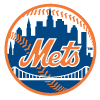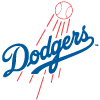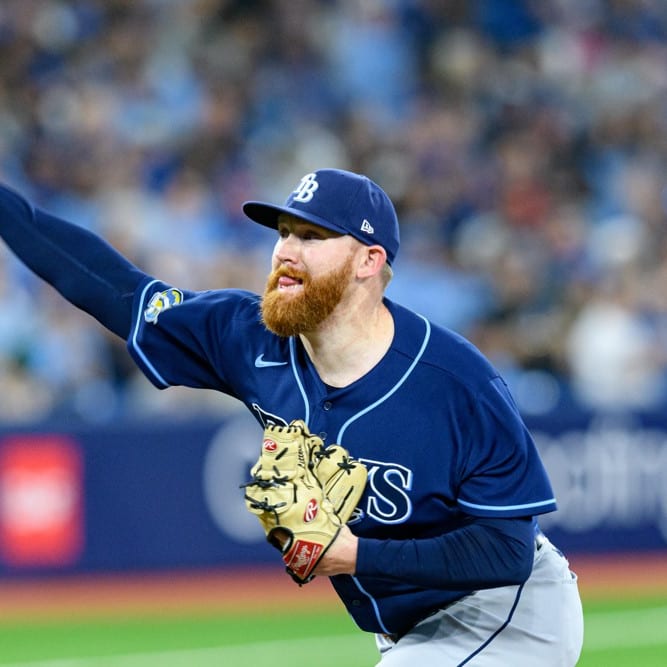This article is part of our MLB Barometer series.
Typically, this column focuses on players who have had recent success or recent struggles. That makes sense, as that's what "Risers and Fallers" implies. While I try to stick with players who are rising and falling in sustainable ways rather than players who have simply had fluky hot or cold streaks, the column is typically very backwards-looking.
I thought it might be fun to shake things up this week with a slightly different take on the topic. Rather than highlighting 10 players who have risen or fallen in the last few weeks, I'll break down 10 players whom I expect to rise and fall in the next few.
In a sense, this isn't too much of a departure from this column's typical subject. These players have indeed risen or fallen recently, at least as long as you're only focusing on their process, not their results. The risers are hitting the ball harder or striking out more opposing batters, while the fallers are whiffing more or giving up more contact. Those things haven't been reflected in their results so far, but if they keep on playing the way they've been playing, their results should match their process stats sooner rather than later.
This edition of the MLB Barometer relies heavily on two Statcast leaderboards: xwOBA for hitters and xERA for pitchers. A quick breakdown for those who don't know those stats well: xwOBA is closely related to wOBA (weighted on-base average). wOBA is an all-encompassing hitting stat that reflects a player's
Typically, this column focuses on players who have had recent success or recent struggles. That makes sense, as that's what "Risers and Fallers" implies. While I try to stick with players who are rising and falling in sustainable ways rather than players who have simply had fluky hot or cold streaks, the column is typically very backwards-looking.
I thought it might be fun to shake things up this week with a slightly different take on the topic. Rather than highlighting 10 players who have risen or fallen in the last few weeks, I'll break down 10 players whom I expect to rise and fall in the next few.
In a sense, this isn't too much of a departure from this column's typical subject. These players have indeed risen or fallen recently, at least as long as you're only focusing on their process, not their results. The risers are hitting the ball harder or striking out more opposing batters, while the fallers are whiffing more or giving up more contact. Those things haven't been reflected in their results so far, but if they keep on playing the way they've been playing, their results should match their process stats sooner rather than later.
This edition of the MLB Barometer relies heavily on two Statcast leaderboards: xwOBA for hitters and xERA for pitchers. A quick breakdown for those who don't know those stats well: xwOBA is closely related to wOBA (weighted on-base average). wOBA is an all-encompassing hitting stat that reflects a player's overall contributions at the plate, weighing the player's results in each plate appearance to produce a number that's scaled to look like on-base percentage. xwOBA goes a step further and uses the expected outcome of each batted-ball rather than the actual outcome, rewarding hitters who crush the ball right into fielders' gloves while penalizing those whose weakly hit balls squeak through the hole. It's scaled the same as wOBA, so a comparison between the two can tell us who's deserved better or worse results than they've managed thus far.
xERA is a relative newcomer to the ERA-estimator scene. ERA estimators typically give pitchers full credit for the things they have most direct control over (strikeouts and walks) while differing on how to account for the increasingly rare occasions when a ball is put into play. FIP, for example, gives a pitcher full credit for his home-run rate while assuming league-average results for every other batted ball. xFIP, which remains my personal favorite based on its combination of simplicity and predictive power, gives a pitcher full credit for his flyball rate but no credit for his HR/FB rate, estimating an ERA based on league-average results in that category as well as for balls in play in general. xERA, on the other hand, gives a pitcher much more credit for his contact management (or lack thereof), estimating an ERA based on the xwOBA he allows hitters to achieve against him.
No expected stat or ERA estimator is perfect, and you won't be behind your league-mates if you look at the "wrong" one. All of them are particularly useful at this point in the season, however. They come with their own noise, but they're valuable checks on some very noisy results-oriented stats like batting average and ERA. The following players have expected stats that are particularly out of line with their results so far and should be expected to perform very differently in the near future.
Future Risers
 Dominic Smith, 1B/OF, Mets: Smith had plenty of hype as a prospect, but a poor .210/.259/.406 line during his first two partial seasons and the emergence of Pete Alonso left his future looking rather murky heading into the 2019 season. That seemed to kick him into another gear, however, as he went on to hit .299/.366/.571 over the next two years. Given that backdrop, his .232/.254/.375 looks rather worrisome, as it looks as though he's back to his old ways. There are some minor concerns here – his 25.4 percent strikeout rate and 3.4 percent walk rate are both his worst marks since 2018 – but his batted-ball numbers remain excellent. The gap between his wOBA (.271) and xwOBA (.407) is third-largest among qualified hitters, with the latter mark actually beating his .390 xwOBA from last season. His .315 xBA and .572 xSLG indicate that he's gotten incredibly unlucky. The Mets are still keeping him in the lineup on a regular basis, so they clearly believe he'll be just fine.
Dominic Smith, 1B/OF, Mets: Smith had plenty of hype as a prospect, but a poor .210/.259/.406 line during his first two partial seasons and the emergence of Pete Alonso left his future looking rather murky heading into the 2019 season. That seemed to kick him into another gear, however, as he went on to hit .299/.366/.571 over the next two years. Given that backdrop, his .232/.254/.375 looks rather worrisome, as it looks as though he's back to his old ways. There are some minor concerns here – his 25.4 percent strikeout rate and 3.4 percent walk rate are both his worst marks since 2018 – but his batted-ball numbers remain excellent. The gap between his wOBA (.271) and xwOBA (.407) is third-largest among qualified hitters, with the latter mark actually beating his .390 xwOBA from last season. His .315 xBA and .572 xSLG indicate that he's gotten incredibly unlucky. The Mets are still keeping him in the lineup on a regular basis, so they clearly believe he'll be just fine.
 Rafael Devers, 3B, Red Sox: Devers sits a few spots behind Smith in the wOBA minus xwOBA leaderboard, ranking sixth among qualified hitters. Unlike Smith, his surface stats are quite good, as his 149 wRC+, the product of a .269/.356/.551 slash line, is already a career high. Per Statcast, however, he's absolutely crushing the ball and deserves far better results. He's more than doubled his barrel rate, which has jumped from 12.1 percent to 25.4 percent, the highest mark in the entire league. That's reflected in his .358 xBA and ridiculous .819 xSLG. He's also making strides in his plate discipline, as his 11.1 percent walk rate is easily a career high, and his 22.2 percent strikeout is down significantly from his 27.0 percent mark last season. For a player with his talent level who's still just 24 years old, a major step forward should be no surprise, and it looks like that leap could be even larger soon.
Rafael Devers, 3B, Red Sox: Devers sits a few spots behind Smith in the wOBA minus xwOBA leaderboard, ranking sixth among qualified hitters. Unlike Smith, his surface stats are quite good, as his 149 wRC+, the product of a .269/.356/.551 slash line, is already a career high. Per Statcast, however, he's absolutely crushing the ball and deserves far better results. He's more than doubled his barrel rate, which has jumped from 12.1 percent to 25.4 percent, the highest mark in the entire league. That's reflected in his .358 xBA and ridiculous .819 xSLG. He's also making strides in his plate discipline, as his 11.1 percent walk rate is easily a career high, and his 22.2 percent strikeout is down significantly from his 27.0 percent mark last season. For a player with his talent level who's still just 24 years old, a major step forward should be no surprise, and it looks like that leap could be even larger soon.
 Ozzie Albies, 2B, Braves: Albies finds himself 17th on the aforementioned leaderboard, with a gap of just over 100 points between his wOBA (.275) and xwOBA (.378). You don't need to even look at his Statcast page to know that something's up, as his .148 BABIP will tell you that he deserves far better than his .164/.256/.373 slash line. His plate discipline is actually as good as it's ever been, as his 9.0 percent walk rate is a career high and his 15.4 percent strikeout rate is down significantly from his 24.2 percent mark last year. His .209 ISO is also a career best, and Statcast backs that up, giving him a career-best .517 xSLG. Once the hits start falling again for Albies, he should perform as well as ever, if not better, which again shouldn't come as a surprise for a 24-year-old with his talent.
Ozzie Albies, 2B, Braves: Albies finds himself 17th on the aforementioned leaderboard, with a gap of just over 100 points between his wOBA (.275) and xwOBA (.378). You don't need to even look at his Statcast page to know that something's up, as his .148 BABIP will tell you that he deserves far better than his .164/.256/.373 slash line. His plate discipline is actually as good as it's ever been, as his 9.0 percent walk rate is a career high and his 15.4 percent strikeout rate is down significantly from his 24.2 percent mark last year. His .209 ISO is also a career best, and Statcast backs that up, giving him a career-best .517 xSLG. Once the hits start falling again for Albies, he should perform as well as ever, if not better, which again shouldn't come as a surprise for a 24-year-old with his talent.
 Jameson Taillon, SP, Yankees: Judging by his 6.23 ERA through his first four starts, Taillon's return from his second career Tommy John surgery isn't going particularly well. His 2.94 xERA tells an entirely different story, however. It may be the most optimistic of the ERA estimators, but his FIP (4.19) xFIP (3.79) and SIERA (3.16) are all much closer to that mark than to his poor ERA. It's not too hard to see why, as his 28.4 percent strikeout rate and 2.7 percent walk rate are both easily career highs. There's at least one reason to worry here, as his 34.0 percent groundball rate is well below his career 47.7 percent mark, but the underlying numbers are on the whole quite encouraging. Hitters have hit like Yordan Alvarez (.352 wOBA) against him, but his xwOBA (.284) says they should be hitting like Jason Heyward.
Jameson Taillon, SP, Yankees: Judging by his 6.23 ERA through his first four starts, Taillon's return from his second career Tommy John surgery isn't going particularly well. His 2.94 xERA tells an entirely different story, however. It may be the most optimistic of the ERA estimators, but his FIP (4.19) xFIP (3.79) and SIERA (3.16) are all much closer to that mark than to his poor ERA. It's not too hard to see why, as his 28.4 percent strikeout rate and 2.7 percent walk rate are both easily career highs. There's at least one reason to worry here, as his 34.0 percent groundball rate is well below his career 47.7 percent mark, but the underlying numbers are on the whole quite encouraging. Hitters have hit like Yordan Alvarez (.352 wOBA) against him, but his xwOBA (.284) says they should be hitting like Jason Heyward.
 Lucas Giolito, SP, White Sox: Giolito's 2.88-run gap between his ERA (5.79) and xERA (2.91) is the largest among pitchers who have faced at least 80 batters this season. Unlike with Taillon, however, the contact he's allowed has generally led to deserved results, as there's only a small gap between his allowed wOBA (.299) and xwOBA (.283). Other luck-related factors appear to be to blame for the righty, most notably his 55.6 percent strand rate. (A pitcher who walks a batter and then gives up a homer generally isn't any worse than one who allows a homer and then a walk, though he's given up twice as many runs.) In the areas where Giolito has more direct control, he's right in line with his numbers from the last two seasons, as he's striking out 32.1 percent of opposing batters while walking just 8.6 percent. He should be the pitcher he was drafted to be going forward.
Lucas Giolito, SP, White Sox: Giolito's 2.88-run gap between his ERA (5.79) and xERA (2.91) is the largest among pitchers who have faced at least 80 batters this season. Unlike with Taillon, however, the contact he's allowed has generally led to deserved results, as there's only a small gap between his allowed wOBA (.299) and xwOBA (.283). Other luck-related factors appear to be to blame for the righty, most notably his 55.6 percent strand rate. (A pitcher who walks a batter and then gives up a homer generally isn't any worse than one who allows a homer and then a walk, though he's given up twice as many runs.) In the areas where Giolito has more direct control, he's right in line with his numbers from the last two seasons, as he's striking out 32.1 percent of opposing batters while walking just 8.6 percent. He should be the pitcher he was drafted to be going forward.
 Andrew Heaney, SP, Angels: According to Heaney's 4.35 ERA through his first four starts, he's been the same decent but fairly interchangeable pitcher that he's been for the last several years. His 2.39 xERA tells a very different story, with his 2.08 FIP and 2.46 xFIP singing a very similar tune. Oddly, he's gotten slightly lucky according to his .257 xwOBA, which comes in above his .225 wOBA. As with Giolito, poor sequencing appears to be to blame, as he owns a 53.8 percent strand rate. If there's reason to believe Heaney is becoming something new in his age-30 season, that rests with his strikeout rate, which has spiked to 36.7 percent, well above his career average of 24.0 percent. He's getting batters to chase outside the zone more than usual (his 32.6 percent swing rate on such pitches is his highest mark since 2016, when he made just a single start), and getting swings and misses inside the zone more than ever (his 78.9 percent zone contact rate is a career best).
Andrew Heaney, SP, Angels: According to Heaney's 4.35 ERA through his first four starts, he's been the same decent but fairly interchangeable pitcher that he's been for the last several years. His 2.39 xERA tells a very different story, with his 2.08 FIP and 2.46 xFIP singing a very similar tune. Oddly, he's gotten slightly lucky according to his .257 xwOBA, which comes in above his .225 wOBA. As with Giolito, poor sequencing appears to be to blame, as he owns a 53.8 percent strand rate. If there's reason to believe Heaney is becoming something new in his age-30 season, that rests with his strikeout rate, which has spiked to 36.7 percent, well above his career average of 24.0 percent. He's getting batters to chase outside the zone more than usual (his 32.6 percent swing rate on such pitches is his highest mark since 2016, when he made just a single start), and getting swings and misses inside the zone more than ever (his 78.9 percent zone contact rate is a career best).
Future Fallers
 Randy Arozarena, OF, Rays: On the surface, Arozarena looks to be somewhat close to what was expected of him. His .278/.337/.430 line through 20 games is no match for his .281/.382/.641 line in 23 games last season or for his ridiculous .377/.442/.831 line in 20 playoff contests, but it's more or less in line with what should have been expected given a reasonable amount of regression. Statcast could hardly be more skeptical, however, as the gap between his wOBA (.338) and xwOBA (.262) is fourth-largest among qualified batters. His 28.9 percent strikeout rate last year hinted at his potential downfall, and that number has spiked to 34.9 percent this season, a number that looks particularly poor next to his 5.8 percent walk rate. Statcast is far from convinced with his quality of contact when he does manage to touch the ball, as his barrel rate has fallen from 14.0 percent to 6.1 percent, leading to a .203 xBA and .324 xSLG. He looks like a clear sell-high candidate.
Randy Arozarena, OF, Rays: On the surface, Arozarena looks to be somewhat close to what was expected of him. His .278/.337/.430 line through 20 games is no match for his .281/.382/.641 line in 23 games last season or for his ridiculous .377/.442/.831 line in 20 playoff contests, but it's more or less in line with what should have been expected given a reasonable amount of regression. Statcast could hardly be more skeptical, however, as the gap between his wOBA (.338) and xwOBA (.262) is fourth-largest among qualified batters. His 28.9 percent strikeout rate last year hinted at his potential downfall, and that number has spiked to 34.9 percent this season, a number that looks particularly poor next to his 5.8 percent walk rate. Statcast is far from convinced with his quality of contact when he does manage to touch the ball, as his barrel rate has fallen from 14.0 percent to 6.1 percent, leading to a .203 xBA and .324 xSLG. He looks like a clear sell-high candidate.
 Tim Anderson, SS, White Sox: Among all batters who count as qualified for Statcast (which requires just 2.1 plate appearances per team game), Anderson's 100-point game between his .385 wOBA and .285 xwOBA is easily the largest. A hamstring injury has limited Anderson to just 12 games, so it's too early to get all that worried here, but a gap that large can't be ignored. Anderson's speed means he should regularly be able to outpace his expected stats, but not by this much; he's beaten his xwOBA by just 26 points over the course of his career. His 26.9 percent strikeout rate is his worst mark since his rookie season, while he's walked just once all year. When he's managed to make contact, it's come off the bat with a career-low 85.3 mph average exit velocity, translating to a .243 xBA, far below his .287 and .291 marks from the two previous seasons.
Tim Anderson, SS, White Sox: Among all batters who count as qualified for Statcast (which requires just 2.1 plate appearances per team game), Anderson's 100-point game between his .385 wOBA and .285 xwOBA is easily the largest. A hamstring injury has limited Anderson to just 12 games, so it's too early to get all that worried here, but a gap that large can't be ignored. Anderson's speed means he should regularly be able to outpace his expected stats, but not by this much; he's beaten his xwOBA by just 26 points over the course of his career. His 26.9 percent strikeout rate is his worst mark since his rookie season, while he's walked just once all year. When he's managed to make contact, it's come off the bat with a career-low 85.3 mph average exit velocity, translating to a .243 xBA, far below his .287 and .291 marks from the two previous seasons.
 Walker Buehler, SP, Dodgers: Buehler's 2.16 ERA suggests he's pitching like the ace he's always expected to be, but his 4.55 xERA isn't in remotely the same ballpark. To be fair to the Dodgers' righty, the other ERA estimators aren't nearly as pessimistic, as he has a 3.10 FIP and 3.55 xFIP, but his statline isn't on the whole nearly as convincing as it could be. He's shown elite control, walking just 1.1 percent of opposing batters, but his 22.1 percent strikeout rate is below league average by a full 2.5 points, a surprise for a pitcher with a career 28.2 percent mark. He's also seen his fastball velocity drop from 96.9 mph to 95.2 percent this season. This may be nothing but an early-season blip, as he did strike out nine Padres on Thursday after striking out just four batters in each of his first three starts, but his velocity was largely unchanged at 95.5 mph, so there's still potential cause for concern.
Walker Buehler, SP, Dodgers: Buehler's 2.16 ERA suggests he's pitching like the ace he's always expected to be, but his 4.55 xERA isn't in remotely the same ballpark. To be fair to the Dodgers' righty, the other ERA estimators aren't nearly as pessimistic, as he has a 3.10 FIP and 3.55 xFIP, but his statline isn't on the whole nearly as convincing as it could be. He's shown elite control, walking just 1.1 percent of opposing batters, but his 22.1 percent strikeout rate is below league average by a full 2.5 points, a surprise for a pitcher with a career 28.2 percent mark. He's also seen his fastball velocity drop from 96.9 mph to 95.2 percent this season. This may be nothing but an early-season blip, as he did strike out nine Padres on Thursday after striking out just four batters in each of his first three starts, but his velocity was largely unchanged at 95.5 mph, so there's still potential cause for concern.
 Zach Eflin, SP, Phillies: Eflin was a pitcher I was quite high on during draft season, as he'd finally paired his good control with a high strikeout rate (28.6 percent) last year. Judging by his 2.77 ERA through his first four starts, it could be time for a victory lap, but his 4.20 xERA isn't nearly so impressive. As with Buehler, that xERA is well above his FIP (3.37) and xFIP (3.87), but his underlying numbers are on the whole somewhat unconvincing. He's walked just 2.0 percent of opposing batters, but his strikeout rate has plummeted all the way back down to 19.2 percent, right in line with his 18.9 percent career mark. He's also suddenly lost his ability to keep the ball on the ground, with his groundball rate falling from 47.4 percent to 36.4 percent. He's given up a 47.4 percent hard-hit rate, well above his 34.5 percent career mark, and his ERA should rise considerably if he can't sort that out soon.
Zach Eflin, SP, Phillies: Eflin was a pitcher I was quite high on during draft season, as he'd finally paired his good control with a high strikeout rate (28.6 percent) last year. Judging by his 2.77 ERA through his first four starts, it could be time for a victory lap, but his 4.20 xERA isn't nearly so impressive. As with Buehler, that xERA is well above his FIP (3.37) and xFIP (3.87), but his underlying numbers are on the whole somewhat unconvincing. He's walked just 2.0 percent of opposing batters, but his strikeout rate has plummeted all the way back down to 19.2 percent, right in line with his 18.9 percent career mark. He's also suddenly lost his ability to keep the ball on the ground, with his groundball rate falling from 47.4 percent to 36.4 percent. He's given up a 47.4 percent hard-hit rate, well above his 34.5 percent career mark, and his ERA should rise considerably if he can't sort that out soon.










